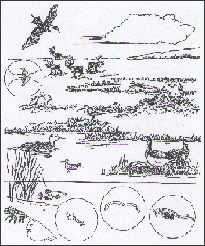| |
|
Tundra 
The tundra is a vast, treeless land of northern and western Alaska and northern Canada. The temperature is very cold in winter and cool in summer. The wind almost always blows. Because of the cold and wind, no trees grow on the tundra. All the plants grow very close to the ground because it is warmer there.
Many people think the tundra is flat. Once you've walked on the tundra, you see that it is made up of lots of little mounds of grass, sedges, and lichens. The low spots are wet or even filled with water, forming little ponds or lakes. The ground is squishy. Even where it looks high and dry, it often isn't. Try sitting on a grassy mound for a few minutes!
Although the tundra feels wet, very little rain or snow falls on the tundra each year. Why is it wet? Because there is permanently frozen ground, called permafrost, under the thin layer of topsoil. Because of permafrost under the soil, most of the rain and snow that falls stays on or near the surface. It can't drain away through the frozen soil. Permafrost doesn't thaw, even in summer. You cannot dig more than a few inches into the frozen soil. However, centuries of decaying vegetation have produced a thick, spongy layer called peat.
Because of permafrost, plants on the tundra have roots that grow sideways (prostrate) instead of straight down. One example is dwarf willow. There are also many berry-producing plants like cloudberry and bearberry on the tundra. Fungi and lichens (Are these plants? What are they?) are very important tundra organisms too.
Millions of shorebirds nest each year on the tundra. They feed on the billions of larvae and hatching insects that appear each summer. They also find aquatic prey like copepods and fairy shrimp.
|
|
|
|
